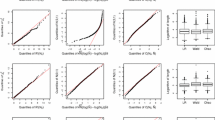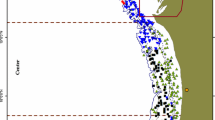Abstract
In this article, we propose a Poisson-Lindley distribution as a stochastic abundance model in which the sample is according to the independent Poisson process. Jeffery’s and Bernardo’s reference priors have been obtaining and proposed the Bayes estimators of the number of species for this model. The proposed Bayes estimators have been compared with the corresponding profile and conditional maximum likelihood estimators for their square root of the risks under squared error loss function (SELF). Jeffery’s and Bernardo’s reference priors have been considered and compared with the Bayesian approach based on biological data.






Similar content being viewed by others
Data availibility
For research analysis purpose we used secondary data, and it have been shared in this manuscript.
References
Barger K, Bunge J (2008) Bayesian estimation of the number of species using noninformative priors. Biom J J Math Methods Biosci 50(6):1064–1076
Barger K, Bunge J et al (2010) Objective Bayesian estimation for the number of species. Bayesian Anal 5(4):765–785
Behnke A, Bunge J, Barger K, Breiner H-W, Alla V, Stoeck T (2006) Microeukaryote community patterns along an o2/h2s gradient in a supersulfidic anoxic fjord (framvaren, norway). Appl Environ Microbiol 72(5):3626–3636
Bernardo JM (1979) Reference posterior distributions for Bayesian inference. J R Stat Soc Ser B (Methodological) 41(2):113–128
Bernardo JM, Ramon JM (1998) An introduction to Bayesian reference analysis: inference on the ratio of multinomial parameters. J R Stat Soc Ser D (The Statistician) 47(1):101–135
Bernardo JM, Smith AF (2009) Bayesian theory, vol 405. Wiley, New York
Bulmer M (1974) On fitting the Poisson Lognormal distribution to species-abundance data. Biometrics 30:101–110
Bunge J, Fitzpatrick M (1993) Estimating the number of species: a review. J Am Stat Assoc 88(421):364–373
Bunge J, Fitzpatrick M, Handley J (1995) Comparison of three estimators of the number of species. J Appl Stat 22(1):45–59
Chao A, Bunge J (2002) Estimating the number of species in a stochastic abundance model. Biometrics 58(3):531–539
Chao A, Lee S-M (1992) Estimating the number of classes via sample coverage. J Am Stat Assoc 87(417):210–217
Colwell RK, Coddington JA (1994) Estimating terrestrial biodiversity through extrapolation. Philos Trans R Soc Lond Ser B Biol Sci 345(1311):101–118
El-Shaarawi AH, Zhu R, Joe H (2011) Modelling species abundance using the Poisson-Tweedie family. Environmetrics 22(2):152–164
Fisher RA, Corbet AS, Williams CB (1943) The relation between the number of species and the number of individuals in a random sample of an animal population. J Anim Ecol 12:42–58
Ghitany ME, Atieh B, Nadarajah S (2008) Lindley distribution and its application. Math Comput Simul 78(4):493–506
Gotelli NJ, Colwell RK (2011) Estimating species richness. Biol Divers Front Meas Assess 12:39–54
Greenwood M, Yule GU (1920) An inquiry into the nature of frequency distributions representative of multiple happenings with particular reference to the occurrence of multiple attacks of disease or of repeated accidents. J R Stat Soc 83(2):255–279
Jeffreys H (1946) An invariant form for the prior probability in estimation problems. Proc R Soc Lond Ser A Math Phys Sci 186(1007):453–461
Jeffreys H (1961) Theory of probability, 3rd edn. OUP Oxford, Oxford
Leite JG, Rodrigues J, Milan LA (2000) A Bayesian analysis for estimating the number of species in a population using nonhomogeneous Poisson process. Stat Probab Lett 48(2):153–161
Lewins WA, Joanes D (1984) Bayesian estimation of the number of species. Biometrics 40:323–328
Lin L-A, Luo S, Davis BR (2018) Bayesian regression model for recurrent event data with event-varying covariate effects and event effect. J Appl Stat 45(7):1260–1276
Lindley DV (1958) Fiducial distributions and Bayes’ theorem. J R Stat Soc Ser B (Methodological) 20:102–107
Lindsay BG, Roeder K (1987) A unified treatment of integer parameter models. J Am Stat Assoc 82(399):758–764
Norris JL, Pollock KH (1998) Non-parametric MLE for Poisson species abundance models allowing for heterogeneity between species. Environ Ecol Stat 5(4):391–402
Ord JK, Whitmore GA (1986) The Poisson-Inverse Gaussian disiribuiion as a model for species abundance. Commun Stat Theory Methods 15(3):853–871
Pathak A, Kumar M, Singh SK, Singh U (2020) Assessing the effect of E-Bayesian inference for Poisson inverse exponential distribution parameters under different loss functions and its application. Commun Stat Theory Methods 51:1–459
Pathak A, Kumar M, Singh SK, Singh U (2020) Bayesian inference: Weibull Poisson model for censored data using the expectation-maximization algorithm and its application to bladder cancer data. J Appl Stat 49(4):926–948
Pathak A, Kumar M, Singh SK, Singh U (2022) Statistical inferences: based on exponentiated exponential model to assess novel corona virus (COVID-19) Kerala patient data. Ann Data Sci 9:1–19. https://doi.org/10.1007/s40745-021-00348-7
R Core Team (2013) The R project for statistical computing. R Foundation for Statistical Computing, Vienna, Austria
Rodrigues J, Milan LA, Leite JG (2001) Hierarchical Bayesian estimation for the number of species. Biom J J Math Methods Biosci 43(6):737–746
Sahlin K (2011) Estimating convergence of Markov chain monte Carlo simulations. Mathematical Statistics, Stockholm University, Stockholm,Sweden
Sanathanan L (1972) Estimating the size of a multinomial population. Ann Math Stat 43:142–152
Sankaran M (1970) The discrete Poisson-Lindley distribution. Biometrics 26(1):145–149
Sichel H (1986) Parameter estimation for a word frequency distribution based on occupancy theory. Commun Stat Theory Methods 15(3):935–949
Wang X, He CZ, Sun D (2007) Bayesian population estimation for small sample capture-recapture data using noninformative priors. J Stat Plan Inference 137(4):1099–1118
Wilson RM, Collins MF (1992) Capture-recapture estimation with samples of size one using frequency data. Biometrika 79(3):543–553
Funding
We would like to confirm that we did not have any funding organization/institute/university that funded our research.
Author information
Authors and Affiliations
Contributions
All co-authors are equally contributed in this manuscript.
Corresponding author
Ethics declarations
Conflict of interest
The corresponding author declares that no competing/conflict of interest emerged among the authors and with no financial assistant.
Ethical approval and consent to participate
This article does not contain any studies with human participants and animal participants performed by any of the authors.
Consent for publication
Not applicable.
Additional information
Publisher's Note
Springer Nature remains neutral with regard to jurisdictional claims in published maps and institutional affiliations.
Rights and permissions
Springer Nature or its licensor (e.g. a society or other partner) holds exclusive rights to this article under a publishing agreement with the author(s) or other rightsholder(s); author self-archiving of the accepted manuscript version of this article is solely governed by the terms of such publishing agreement and applicable law.
About this article
Cite this article
Pathak, A., Kumar, M., Singh, S.K. et al. Bayesian estimation of the number of species from Poisson-Lindley stochastic abundance model using non-informative priors. Comput Stat (2024). https://doi.org/10.1007/s00180-024-01464-7
Received:
Accepted:
Published:
DOI: https://doi.org/10.1007/s00180-024-01464-7




